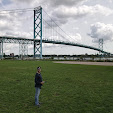The lower Connecticut River valley is among the most
scenic and quiet areas in all of southern New England. It is hard to imagine
that this area is actually right in the center of the busy New York to Boston
segment of the sprawling Northeast Corridor. Of all the small towns and tiny
villages that dot the landscape of this region, one seems to stand out above
all the rest – a town located on the Connecticut River full of important
landmarks and scenic attractions of all kinds that are bound to leave a
memorable impression on travelers alike.
The village of East Haddam was incorporated in 1734 and
is home to several historic buildings & structures that have been central
to the town’s identity since colonial times. The Gelston House is a historic
hotel & restaurant establishment dating as far back as 1853. The House
offers an upscale lodging & dining experience for travelers of all kinds
and operates year-round. A short distance north of the main village is the
Nathan Hale School House, a historic one-room schoolhouse site notable for
being a location where Connecticut’s official “state hero” briefly taught in 1773.
Hale went on to serve as an American soldier and spy for the Continental Army
during the American Revolutionary War. He was captured by the British during an
intelligence-gathering mission behind enemy lines (while attempting to gather
information about British troop movements in the New York City area) and was executed
in 1776.
Aside from the Opera House, the most recognizable
landmark in the village is the bridge spanning the Connecticut River nearby.
The East Haddam Bridge was built in 1913 and is an impressive steel truss swing
bridge built in an ornate style that easily blends in with the surrounding
natural and man-made landmarks. A link to an additional blog post about this
bridge (including other information and photos) will be found at the bottom of
this article.
Located on the west bank of the river immediately across the bridge is the historic Goodspeed Train Station, built as a stop on the old Connecticut Valley Railroad. Nowadays, it’s home to an antique/general store and is the starting point for a unique railbike attraction run by the Valley Railroad Company. Steam train and riverboat excursion tours are offered in this area, some of which originate their journey here in East Haddam at the Goodspeed Station and/or at the nearby Eagle Landing State Park; all can often be spotted along the tracks and the nearby Connecticut River during the warm months of the year.

































Comments